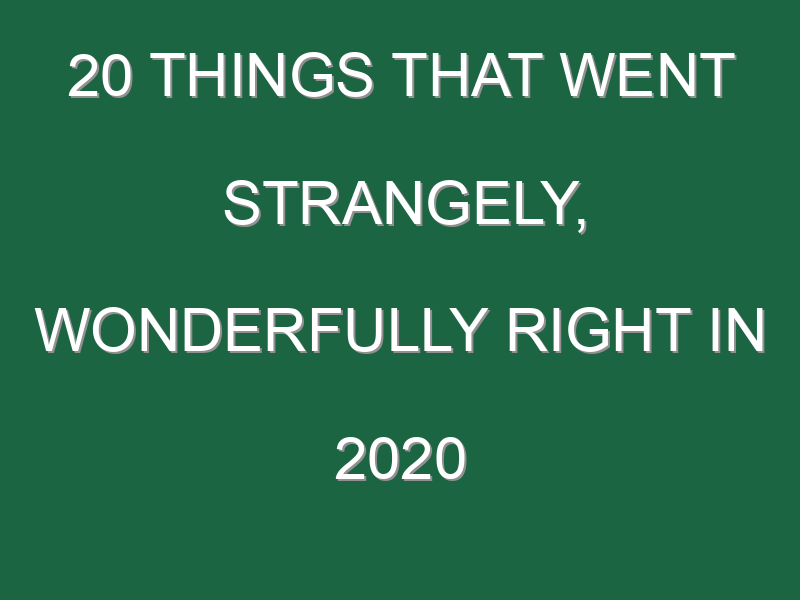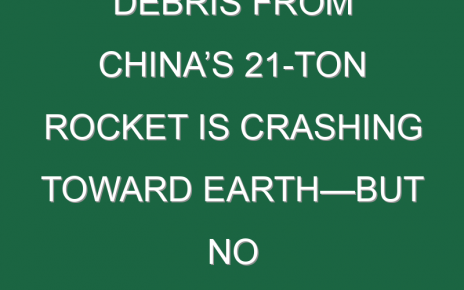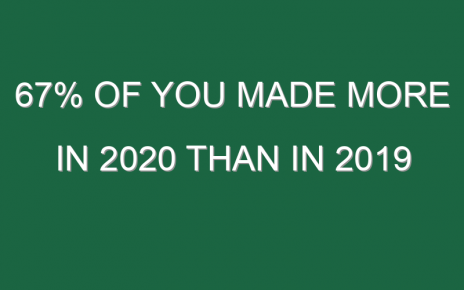So long, annus horribilis. Farewell, O rotten plague year. Dominus vobiscum. But as we utter our long-practiced goodbyes to 2020, let us pause for a moment to reflect upon the glad tidings that lay hidden in its miasmic haze. Yes, surprising as it may seem, there were some things that turned out darn well in 2020—and a few that even reaffirmed that the arc of history is bending the right way. Here’s a not-so-short list.
20. Dolly Parton helped fund a coronavirus vaccine. With 10 Grammy wins, a half-century-long parade of country music accolades, and more lifetime achievement awards than any mere mortal could achieve in a lifetime, Parton may not have much room on her mantle for another statuette. But surely she deserves two more—one for generosity, the other for prescience. In April, the grandest of Ole Opry singer-songwriters gave $1 million to Vanderbilt University Medical Center to support research into treatments for COVID-19. Some of that money, as it happens, went to fund early investigations for a revolutionary coronavirus vaccine that biotech company Moderna would ultimately produce by year’s end. And Parton’s gift came at a critical moment. As one Vanderbilt researcher told the New York Times: “Her money helped us develop the test that we used to first show that the Moderna vaccine was giving people a good immune response that might protect them.”
19. Murder hornets were not as murderous as feared. When news broke in May that a species of serial-killer wasps had descended in North America, it felt very much on brand for 2020 and its seeming calendar of calamity. But so far, these bee-colony marauders haven’t been the disaster many feared. (Not yet anyway.) In October, entomologists in Washington state and at the USDA cleverly tracked down and eradicated one nest of the hornets, offering hope for a viable containment plan. And, well, others suggested that maybe the threat wasn’t so dire in the first place.
18. Chess became cool. A Netflix limited series did what generations of grade-school grand masters could never do: make chess binge-worthy. “The Queen’s Gambit,” Netflix’s record-breaking show based on the 1983 novel by Walter Tevis, has reportedly led to a boom in sales of chess sets and visitors to sites like Chess.com. The secret sauce for the game of kings, it turns out, is a queen.
17. Women physicists got a spotlight. Physicists have long debated the matter of glass’s form of matter. Is it a liquid? A solid? An amorphous in-between, as some have defined it? Whatever the case may be, it’s clear that in science—as in many other professions—glass can form a pretty durable ceiling. 2020 didn’t exactly undo that, but it did offer some opportunity for giving credit where credit is due. In January, the American Physical Society presented its highest award, the Medal for Exceptional Achievement in Research, to Myriam P. Sarachik (now 87), who is only the fifth recipient of the prize. (The award was announced the previous August.) Sarachik, who shares some of her cinematic life story here, did pivotal experiments at Bell Labs in the 1960s demonstrating why certain metallic substances resist the conductivity of electric current and helped solve a number of other physical mysteries in her long career. (The Times’ Kenneth Chang has a nice write-up here.) At the other end of the age spectrum, two MIT physicists, Tracy Slatyer and Netta Engelhardt, received major prizes—the first for her seminal work on dark matter (the stuff that makes up more than 80% of the universe); the second for helping to “calculate the quantum information content of a black hole.”
16. Someone learned how to make vodka from air.
15. We welcomed colleagues into our living rooms, kitchens, and basements. The WFH evolution has brought with it an epidemic of Zoom fatigue and a blurred line between “work” and everything else. But at the same time, it has also erased the hierarchies of office culture and brought a new familiarity among coworkers as colleagues have become regular house guests too. In the backgrounds of our videoconference lairs, we spot the signals of once-hidden selves, of unknown habitats and hobbies, of unseen family and friends—and we are comforted to know that there’s life in the work-life mélange after all.
14. The Moon, Mars, and stars got a little closer. Even as our personal space may have shrunk in the pandemic age, the edge of outer space seemed nearer than ever. In May, SpaceX’s Crew Dragon spacecraft, carrying astronauts Douglas Hurley and Robert Behnken, docked with the International Space Station, marking the first time that NASA astronauts had made such a journey—blasting off from American soil in a craft built and operated by a private U.S. company (one founded, of course, by Fortune’s 2020 Businessperson of the Year, Elon Musk). The flight, part of NASA’s public-private “Commercial Crew Program”—which has partnered the government space agency with SpaceX and Boeing—puts America one step closer to the moon (again), and ultimately to Mars.
13. It happened: the octogenarian sex symbol. In the plague year, there seemed to be nothing that slowed Dr. Anthony Fauci down—not the pressure of being the public face in the war on COVID-19, not being caught in the political crossfire, and apparently not turning 80, which the good doctor did on Christmas Eve. A September poll by the Kaiser Family Foundation found that 68% of Americans have “a great deal” or “a fair amount” of faith in Dr. Fauci to provide reliable information about the coronavirus—making him a rare entity in the pandemic era: somebody trusted by the vast majority of the country. But it was “Saturday Night Live” that captured the fullness of Fauciphilia in its Dec. 12 “cold open.” As the Kate McKinnon-played physician tried to deliver news about the Pfizer coronavirus vaccine, enraptured women threw their bras at him. Said the faux Fauci: “Any other year, I’m a two. This year, I’m a 10.”
12. Americans voted in record numbers. More than 158 million Americans—or 66.3% of those eligible to vote—cast a ballot in the 2020 presidential election, the highest turnout in over a century. The share this year was more than six percentage points higher than it was in 2016 and included record-breaking turnout in 42 states and the District of Columbia, according to the Washington Post. Whomever you voted for, it’s an unalloyed good thing that so many Americans put their faith in masks and mailboxes and exercised their sacred right to vote.
11. Courts upheld the rule of law. As impressive as voter participation was in the November election, efforts to discredit it in the weeks since then have been equally dispiriting—that is, except for one thing: U.S. courts have consistently and overwhelmingly quashed this prolonged assault on voter rights. In the 60 state and federal court cases that have been decided so far, judges in 59 of them—many of them appointed by Republicans, and some by President Trump himself—have rejected an unending chain of spurious claims of election fraud. In late November, the U.S. Court of Appeals for the Third Circuit unanimously dismissed one such case challenging Pennsylvania’s election results with a scathing rebuke: “Free, fair elections are the lifeblood of our democracy,” wrote Circuit Judge Stephanos Bibas, whom Trump appointed to the court in 2017. “Charges of unfairness are serious. But calling an election unfair does not make it so. Charges require specific allegations and then proof. We have neither here.”
10. From monolith to Gingerlith, mystery-makers reigned. It started in late November, with the discovery of a nearly 10-foot metal pillar in Utah’s Red Rock country. A crew of state public safety and wildlife workers found the slim, sun-glazed tower while doing an aerial tally of bighorn sheep in a craggy and remote section of southeastern Utah. Then, just a few days later, it was gone. The global fascination was such that the “Utah monolith,” as it became known, earned its own Wikipedia page. Soon, other monoliths began popping up (and disappearing) across the world, from a flower bed in Fayetteville, North Carolina, to a hill in northeastern Romania. But the pièce de resistance of this performance art was the 7-foot iced gingerbread tower, dubbed the “Gingerlith,” that appeared in San Francisco’s Corona Heights Park on Christmas Day. Phil Ginsburg, general manager of the city’s recreation and parks department, said for his part, he would “leave it up until the cookie crumbles.” And that it did the very next day.
9. We learned about the odd things we missed. In April, as the harsh reality of social distancing was becoming clear to millions, actor Seth Rogen tweeted out a sentiment that elegantly captured what was being lost: “Really looking forward to being bad at making eye contact again.” Over the past several months, social media has offered a collective confessional of the unexpected things we find ourselves longing for—from the rituals of daily commutes to a litany of once-familiar, but now-faded smells. With that has come a recognition, for many, of how extraordinary everyday life actually was—and that itself is a worthy thing to emerge from 2020’s lonely caverns.
8. A Nobel Prize went to CRISPR’s true discoverers. On Oct. 7, the Royal Swedish Academy of Sciences awarded the 2020 Nobel Prize in Chemistry to Emmanuelle Charpentier and Jennifer Doudna for discovering a “tool for rewriting the code of life,” the committee said. That tool, a genetic scissors known as CRISPR/Cas9, is already being used to develop pinpoint cancer treatments, fix inherited genetic disorders, and create superfast diagnostic tests for COVID-19. The awesome lifesaving potential of CRISPR, a molecular technique borrowed from the ancient arsenal of bacteria, has been celebrated for years—since Doudna and Charpentier published their landmark 2012 paper in the journal Science. But until the Nobel committee’s October announcement, there had been swirling questions about who would receive the ultimate peer acknowledgment for the discovery, given the competing claims from rival scientists at MIT, Harvard, and elsewhere. (You can read about the often-bitter battle over CRISPR-related patents here and here.) The awarding of the Nobel Prize to Charpentier and Doudna is a bang of history’s gavel, however. It may not end the legal wrangling, but it is a clear verdict from the community of science.
7. The Mandalorian, Season 2. Enough said.
6. A.I. solved the protein-folding problem. Sure, the victories against Go masters a few years back were impressive. But in what may be the clearest example yet of what artificial intelligence can achieve, a team at Alphabet’s DeepMind A.I. unit solved an enigma that scientists have been struggling to decode for half a century—predicting precisely how a protein will bend and coil and twist upon itself based on its building blocks of amino acids. The unique and often wildly intricate shape of a protein is critical to its function. Misfolded proteins (if they aren’t fixed or destroyed by the body) can cause a host of human diseases. And so understanding what can go wrong (or even how to construct a viable protein from scratch) is an important goal with a multitude of scientific and medical implications. Given the task of predicting the structure of more than 100 proteins, DeepMind’s A.I. software, as Fortune’s Jeremy Kahn reported in November, identified the conformation in some two-thirds of cases “to within about an atom’s width of accuracy,” and was highly accurate predicting most of the rest.
5. Science prevailed. On Jan. 12, the genetic sequence of the novel coronavirus, SARS-CoV-2, was published. On Dec. 11, the FDA approved the first vaccine, one developed by Pfizer and the German firm BioNTech, for emergency use. A week later, the FDA gave the go-ahead to a second vaccine, this one from Moderna. (A third vaccine, by AstraZeneca in collaboration with Oxford University, was approved by UK regulators on Dec. 30.) The speed of this progress—trouncing every land-speed record for vaccine development in history—has been nothing short of mind-blowing. Consider, for context, that the infectious agent that causes malaria has been known for 140 years and there still, as yet, is no approved vaccine to prevent the disease. Same goes for tuberculosis, and for more newly discovered scourges such as AIDS. Making a truly effective and safe vaccine can be an arduous and vexing process, as Fortune’s Erika Fry chronicles in her jaw-dropping feature on Sanofi’s efforts to develop a vaccine against dengue fever. So the success in developing several different versions against COVID-19 is all the more remarkable. At the same time, 2020 saw research scientists and a host of others across industry, government, academia, and philanthropy race to produce antiviral medicines, monoclonal antibodies, and other therapies to treat COVID-19, rapid tests to diagnose it, and medical strategies to heal those who have gotten sickest from it. All of that has helped bring case fatality rates down sharply since April. As terrible as the pandemic has been, the call to arms against it has been a thing to celebrate.
4. Collaboration proved its worth. As brilliant and unyielding as medical science has been in its war against COVID-19, it has had an assist from a, perhaps, unlikely source: a collaborative spirit among companies, academic institutions, and governments. Corporate rivals have come together. New partnerships have formed on the fly around the world. And in the case of the vaccine race, the sudden embrace of cooperation in the pharma industry has been particularly noteworthy. “I have never seen the level of collaboration that’s going on today,” Bristol Myers Squibb CEO Giovanni Caforio told the gathering at Fortune’s Brainstorm Health event this summer. “So,” he went on to ask, “how do we take what we’ve learned in the last six months and apply it to cancer?” That’s the question for 2021.
3. Air pollution levels dropped. In November, researchers at NASA revealed that computer models had shown a sharp drop in nitrogen dioxide levels in the Earth’s atmosphere, echoing other research findings. While it makes sense that, during a period of lockdowns around the globe, there would be a decrease in the chemical (which is produced by the combustion of fossil fuels), the amount of the drop surprised the NASA team. Various analyses in the spring showed little decline in air pollution, despite the steep decrease in traffic and economic activity—and some areas, like Southern California, remain as smoggy as ever. But by year’s end, it seems, at least a sliver of blue sky emerged on the climate front. In a report published on Dec. 11, the Global Carbon Project estimated that the world will have thrust some 37 million metric tons of carbon dioxide into the atmosphere in 2020. As frightening as that figure sounds, it’s actually 7% less than was produced the year before. Indeed, this year’s drop in emissions may be the biggest ever. (Unfortunately, when economic activity and travel resume full bore, CO2 will spew anew, the researchers say.)
2. Nonviolent protest worked. Eight minutes and 46 seconds. That was how long it was initially thought that a white Minneapolis police officer kept his knee pinned on George Floyd’s neck. A later analysis of eyewitness videos by the New York Times put the time at eight minutes and 15 seconds. But whatever the precise duration of this deadly assault was, it was enough to kill Floyd and trigger something else in cities and towns across the world. The slow-motion suffocation of Floyd—following the police killings of Breonna Taylor, Freddie Gray, Michael Brown, Walter Scott, Philando Castille, Eric Garner, and so many others—brought widespread outrage over something that had long been known: that our system of policing is plagued by a deep-seated and enduring racial bias. Black men are anywhere from 2.5 times to 3.2 times more likely to die at the hands of police than white men, according to various studies. In the wake of Floyd’s killing, though, the cries turned into crowds. Between May 26, the day after Floyd’s death, and Aug. 22, there were “over 7,750 demonstrations linked to the Black Live Matters movement across more than 2,440 locations in all 50 states and Washington, DC,” according to the Armed Conflict Location & Event Data Project. Roughly 93% were absent of any violence, according to ACLED. There will be those who will say these peaceful rallies and marches did nothing to alter the landscape of racism in this country. But history is replete with examples of the power of such nonviolent protest. If 2020 marks the beginning of change, it will be something to say thanks for.
1. The world didn’t end. Happy New Year, everyone.





